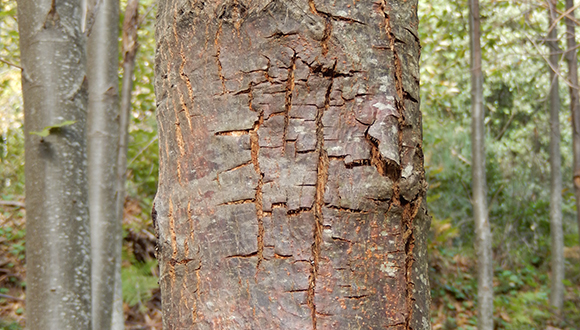Fungi and drought, a potentially fatal cocktail for forests
A new scientific article published by members of CREAF, the Autonomous University of Barcelona, and the Swedish University of Agricultural Sciences reveals that when a forest is attacked by certain fungi during an episode of drought, tree mortality multiplies. The article explains the two classes of fungi which benefit from situations of drought and how they colonize and end up killing trees through food and water starvation.

Ecologists from CREAF and the Autonomous University of Barcelona, experts in drought, and ecologists from the Swedish University of Agricultural Sciences (Sveriges lantbruksuniversitet), experts in forest fungi, have joined their respective knowledge and recognized that when certain fungi attack a forest during an episode of drought, the death of colonized trees is both increased and accelerated. The work published in the journal New Phytologist analyzes the effects of the fungi on the transport systems and storage of water and carbon of the trees, and explains why different types fungi can be more or less dangerous in a scenario of severe drought.
Up to now it was already known that plagues and other forest pathogens contribute to the process of forest mortality in conditions of drought. “Many insects, for example, attack trees debilitated by drought, accelerating death”, comments Jordi Martínez-Vilalta, CREAF researcher and UAB professor. However, the role of pathogenic fungi, despite being present in almost all of the plant, was much less known.

Some fungi kill by starvation and others cause embolisms
This review work identified two groups of fungi that are especially dangerous for forests during droughts. First are the necrotrophic fungi which feed on the carbon and nutrients of dead cells. These fungi damage the trees’ tissues that transport carbohydrates, at the same time triggering a crucial defensive response in the tree. This response results in the investment of a large quantity of sugars into producing defensive substances. All together, these conditions lead to a death by starvation. On the other hand there are the vascular fungi, fungi which colonize the conduits of the trees’ hydraulic system, blocking water transport and favoring the formation of embolisms in intense drought conditions. In Catalonia there are examples of both types of fungi: the chestnut blight (Cryphonectria parasitica) is caused by a necrotroph, and Dutch elm disease (Ceratocystis novo-ulmi) is provoked by a vascular fungus.
Other fungi such as the biotrophic fungi, which feed on living cells in leaves, don’t represent any additional risk in the case of drought because they themselves suffer from the effects of water scarcity and their proliferation is quite limited.
If we don’t adopt adequate forest management to deal with diseases, the synergistic effect of blight and drought could lead to the total disappearance of chestnuts in affected areas
“Taking into account interactions between pathogenic fungi and the process of tree mortality will improve our capacity to predict which forests, under what conditions, will suffer episodes of mortality as the climatic conditions become drier”, comments Jonàs Oliva from the Swedish University of Agricultural Sciences.
On the ground, according to Josep Maria Riba, expert in forest plagues, we are already seeing the impact of these interactions: “we are seeing that the continuing episodes of drought caused by climate change are making chestnuts more vulnerable to blight. Chestnuts are suffering attacks of blight which are increasingly severe and wreck their populations".
Article reference
Oliva, J., Stenlid, J. and Martínez-Vilalta, J. (2014), The effect of fungal pathogens on the water and carbon economy of trees: implications for drought-induced mortality. New Phytologist, 203: 1028–1035. doi: 10.1111/nph.12857







